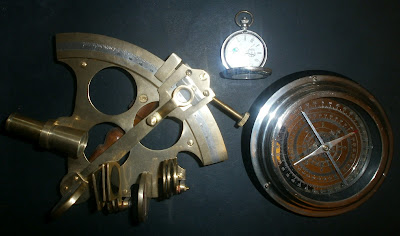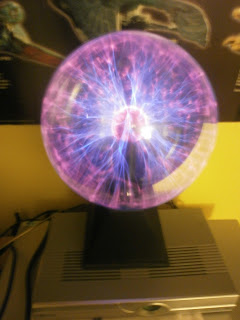"I must go down to the seas again, to the lonely sea and the sky,
And all I ask is a tall ship and a star to steer her by..."
John Masefield, 'Sea Fever' (1902)
You might not realize it while looking at the stars with your naked eye, but stars are constantly moving across the sky. This is because of the Earth's rotation along its North-South axis, which makes relatively stationary stars in the night sky appear to move slowly in a circular fashion. So it's not so much the stars moving - it's you who's moving!
This movement can be clearly seen if you have a magnified look at a star with a fixed telescope or pair of binoculars - the star will appear to travel slowly across your field of view in the eyepiece. A good demonstration of this can be seen in my video below, taken in real time through my telescope, of Procyon, in the constellation Canis Minor.
Note that Procyon is actually a binary star system, consisting of a bright white main sequence star named Procyon A and a faint white dwarf companion named Procyon B, the very much fainter star which you can just about see to the left of Procyon A in the video above. However, both stars can clearly be seen to be travelling slowly across the sky from left to right in the video above.
There is, however, one star among the thousands that you'll be able to see in the night sky that does NOT seem to move at all. This is Polaris, in the constellation Ursa Minor, and a clue as to why this star does not seem to move at all is in the name. Polaris is a short form of the Latin 'stella polaris', which means "pole star". The star lies nearly in a direct line with the North-South axis of the Earth's rotation and, as a result, appears to stand almost motionless in the sky, as the Earth and all the stars of the Northern sky appear to rotate around it.
And if you don't believe me, below is a video of Polaris, taken on the same night as the video of Procyon above, using the same telescope and video settings and captured in real time as well. You can see that Polaris hardly moves at all.
An even clearer demonstration of this effect are star trails. If you were to point your camera at Polaris and take a large number of long-exposure photographs (varying from 30-second to 10-minute exposures, depending on lighting conditions and your camera's capabilities) and combine them into a single image, the photo below will be the result - the motion of the stars leaving a trail ofcircles across the night sky, with the motionless Polaris at the centre of these concentric circles.
Because of this unique position that Polaris is in, the star used to be crucial in the old days of naval navigation by the stars. The navigator only needs to find Polaris to find which direction is North. And Polaris is easy to find - even on a cloudy, light-polluted sky, as in the picture on the right. Just locate the two stars that form the outer edge of the 'bowl' of the Big Dipper (called the Plough here in England but I prefer to refer to it as the Saucepan!) Draw an imaginary line straight through the two stars of the dipper edge and the first star it hits of about the same brightness would be Polaris.
In addition, because the star is so far away from Earth (434 light-years), the angle from the horizon to Polaris is the same as the latitude. This angle can be measured precisely using a sextant. Once the latitude is known, all that is then required is to find the longitude. Unfortunately, finding longitude is a bit more complicated - it relies on noting the time at which other stars rise, set, or reach a known position in the sky.
Among my prized possessions in the living room are a brass sextant, naval compass and pocket chronometer (see picture on the left). So, if the Sat Nav, GPS or tom-tom in the car should go on the blink one clear dark night, the only things I'd need would be my trusty sextant and chronometer - and, of course, a star to steer her by!
All photographs on this page © Sabri Zain 2012.
And all I ask is a tall ship and a star to steer her by..."
John Masefield, 'Sea Fever' (1902)
You might not realize it while looking at the stars with your naked eye, but stars are constantly moving across the sky. This is because of the Earth's rotation along its North-South axis, which makes relatively stationary stars in the night sky appear to move slowly in a circular fashion. So it's not so much the stars moving - it's you who's moving!
This movement can be clearly seen if you have a magnified look at a star with a fixed telescope or pair of binoculars - the star will appear to travel slowly across your field of view in the eyepiece. A good demonstration of this can be seen in my video below, taken in real time through my telescope, of Procyon, in the constellation Canis Minor.
Note that Procyon is actually a binary star system, consisting of a bright white main sequence star named Procyon A and a faint white dwarf companion named Procyon B, the very much fainter star which you can just about see to the left of Procyon A in the video above. However, both stars can clearly be seen to be travelling slowly across the sky from left to right in the video above.
There is, however, one star among the thousands that you'll be able to see in the night sky that does NOT seem to move at all. This is Polaris, in the constellation Ursa Minor, and a clue as to why this star does not seem to move at all is in the name. Polaris is a short form of the Latin 'stella polaris', which means "pole star". The star lies nearly in a direct line with the North-South axis of the Earth's rotation and, as a result, appears to stand almost motionless in the sky, as the Earth and all the stars of the Northern sky appear to rotate around it.
And if you don't believe me, below is a video of Polaris, taken on the same night as the video of Procyon above, using the same telescope and video settings and captured in real time as well. You can see that Polaris hardly moves at all.
An even clearer demonstration of this effect are star trails. If you were to point your camera at Polaris and take a large number of long-exposure photographs (varying from 30-second to 10-minute exposures, depending on lighting conditions and your camera's capabilities) and combine them into a single image, the photo below will be the result - the motion of the stars leaving a trail ofcircles across the night sky, with the motionless Polaris at the centre of these concentric circles.
In addition, because the star is so far away from Earth (434 light-years), the angle from the horizon to Polaris is the same as the latitude. This angle can be measured precisely using a sextant. Once the latitude is known, all that is then required is to find the longitude. Unfortunately, finding longitude is a bit more complicated - it relies on noting the time at which other stars rise, set, or reach a known position in the sky.
Among my prized possessions in the living room are a brass sextant, naval compass and pocket chronometer (see picture on the left). So, if the Sat Nav, GPS or tom-tom in the car should go on the blink one clear dark night, the only things I'd need would be my trusty sextant and chronometer - and, of course, a star to steer her by!
All photographs on this page © Sabri Zain 2012.



























